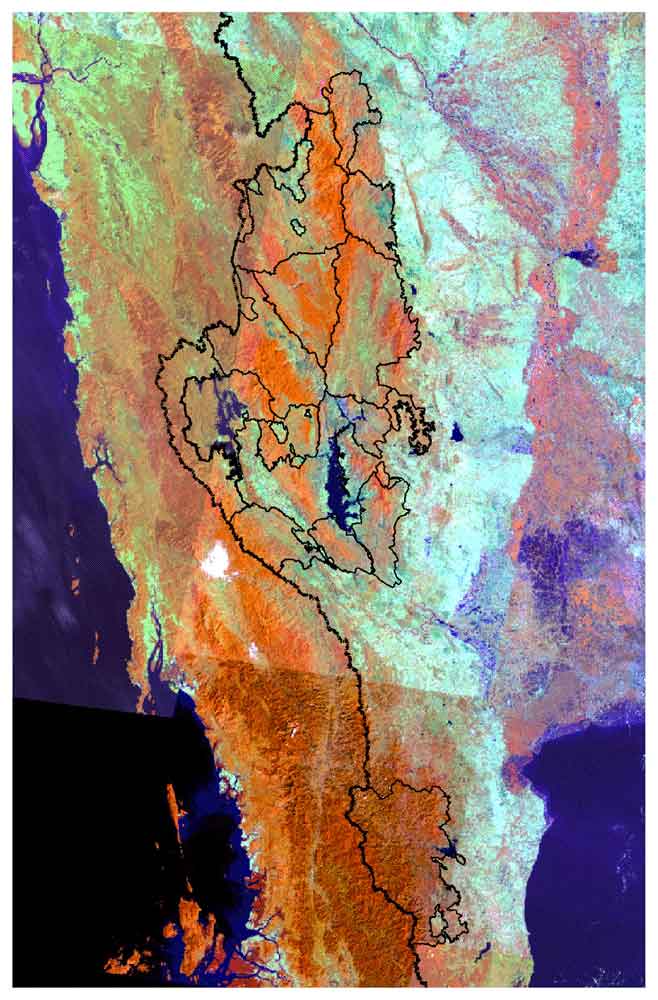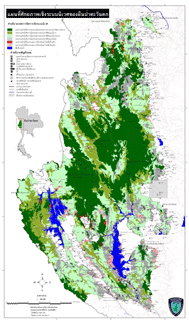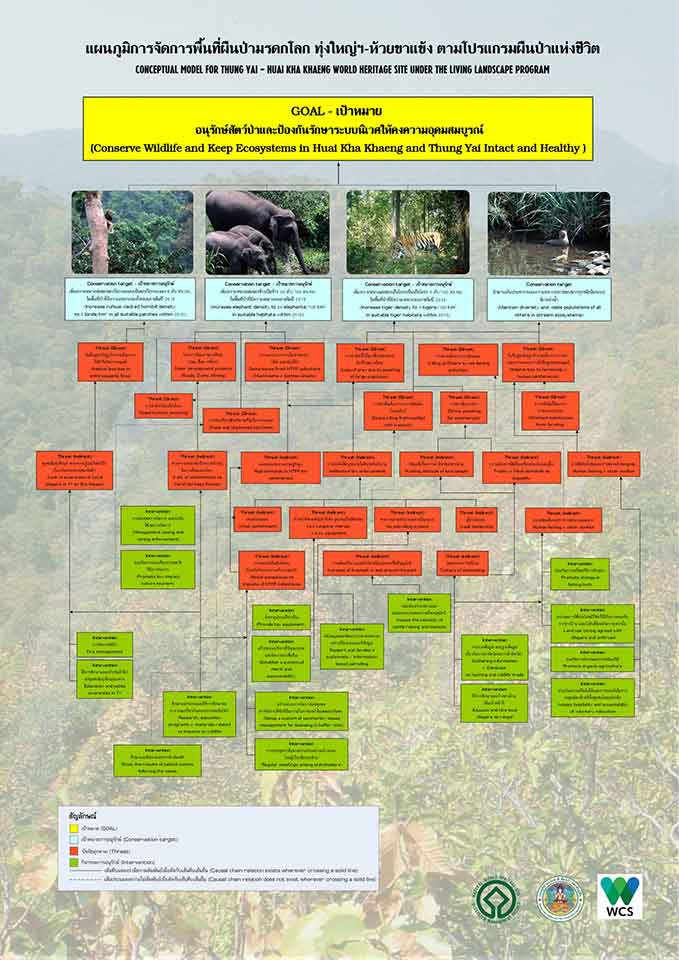NATURAL SIGNIFICANCE
 Covering an area of about 18,000 sq. km. extended into Myanmar border along the Tennaserim Range, THAILAND'S Western Forest Complex (WEFCOM) is considered as the largest remaining forest track in the mainland Southeast Asia that is made up of 17 contiguous protected areas; 11 national parks and 6 wildlife sanctuaries. Three large protected area Huai Khakhaeng (2,780 sq.km.), Thungyai Naresuan West (2,118 sq.km.), and Thungyai Naresuan East (1,572 sq.km.) make up the core area, the most important stronghold for wildlife in the region which was recognized as a World Heritage Site in 1991. This core area lies at the heart of Western Forest Complex's protected area system.
Covering an area of about 18,000 sq. km. extended into Myanmar border along the Tennaserim Range, THAILAND'S Western Forest Complex (WEFCOM) is considered as the largest remaining forest track in the mainland Southeast Asia that is made up of 17 contiguous protected areas; 11 national parks and 6 wildlife sanctuaries. Three large protected area Huai Khakhaeng (2,780 sq.km.), Thungyai Naresuan West (2,118 sq.km.), and Thungyai Naresuan East (1,572 sq.km.) make up the core area, the most important stronghold for wildlife in the region which was recognized as a World Heritage Site in 1991. This core area lies at the heart of Western Forest Complex's protected area system.
Among scattered fragmented forest throughout the country, WEFCOM is a wildlife oasis otherwise transformed by economic development. The flora and fauna is a unique mix of 4 regions and therefore unparalleled in South-East Asia, many of them are rare, endangered or endemic. The intact forest abound with species disperse from other zoogeographical ranges, such as rufous-necked hornbill from India subregion, tapir from Sundaic subregion, etc. With its large size and as the zoogeographical range center, WEFCOM therefore the intact forest with intense wildlife diversity nurturing over 150 mammals, 490 birds, 90 reptiles, 40 amphibians, and 108 fish. The wildlife diversity is not the only sustainable index of wildlife, however, also its population size.
The Conservation Concept of WEFCOM
 Effective conservation strategy for WEFCOM bases on the vision that the whole area is unique. It is the idea of Seub Nakhasatien, a former well-known Thai conservationist that To protect Thungyai-Huai Khakhaeng in the sustainable way is to consider the whole WEFCOM in unique. From this concept, it is clear that the explicated conservation measures and effective monitoring strategies are significant.
Effective conservation strategy for WEFCOM bases on the vision that the whole area is unique. It is the idea of Seub Nakhasatien, a former well-known Thai conservationist that To protect Thungyai-Huai Khakhaeng in the sustainable way is to consider the whole WEFCOM in unique. From this concept, it is clear that the explicated conservation measures and effective monitoring strategies are significant.
During 2001 - 2003, a group of DNP's managers and researchers led by Chatchawal Pisdamkham formed a WEFCOM Project and introduced the ecosystem management concept to the area. The key concept used during the period was to manage natural resources using system concepts to ensure that all plants and animals in ecosystems are maintain at viable levels in native habitats and that basic ecosystem processes are perpetuated indefinitely. When the project ended the key results that can be fundamental to future management of the areas include distribution maps of large mammals and birds, GIS database on local communities and socio economic data, formations of Provincial Conservation Flora for 6 provinces around WEFCOM, and some degrees ranger capacity improvement.
WCS and WEFCOM
In 2004 - 2005 after Anak Pattanavibool, a former field manager of WEFCOM Project, became WCS Thailand Program Director, he has studied WCS's Living Landscape Program and found it very useful and promising to adopt under the biological conditions and development of conservation movement for WEFCOM. Anak sees the strengths of LLP are an explicit link between management and science, a clear conservation target that keeps focus on wildlife as called landscape species, and an importance of monitoring system as an integral part of the process. He has introduced the colleagues in the government, academic institutes, and NGOs to try to adopt LLP approach. HKK-TY was selected to be the priority area due to the capacity of the area, management, and teamwork. The request was well supported by Amy Vedder the Director of LLP. The first step then happened when Amy Vedder, Peter Clyne, Etienne Delattre came to lead the Living Landscape Program Workshop in December 2005. WCS Thailand hosted the workshop with the co-hosts are LLP, Asia Program, and the World Heritage Project.
The Living Landscape Program (LLP) workshop aimed to build a conceptual model and monitoring framework for Huai Kha Khaeng - Thung Yai (HKK - TY) world heritage site. There were 39 participants from 18 organizations from the Department of National Park, Wildlife, and Plant Conservation, Universities, local NGOs, WCS Living Landscape Program, WCS Asia Program, and WCS Thailand Program. The workshop was led by Dr.Amy Vedder the head of WCS LLP Program. Off 31 candidates for landscape species, 4 species were selected as landscape species for HKK - TY. These were the tiger, elephant, rufous-necked hornbills and otters. Then these landscape species were used as a baseline to construct a conceptual model first for each species and priority monitoring framework. Then the individual species models were consolidated and will use as a conceptual model for HKK - TY landscape. Priority monitoring frameworks were also identified. The next steps will be to promote the use of this conceptual model as a guidance for improve conservation of HKK - TY landscape.
Up to now, the priority interventions undertaken at the moment include setting up a systematic patrol system and population monitoring systems for tiger's prey, tigers, and rufous-necked hornbills to estimate the baseline densities for each species in the key sample sites. In the future, along with other government agencies (mainly under DNP), universities (KU, MU, CU, KMUT) and local NGOs (e.g., SNF, WFCC, PCFs) who also work on some other interventions in and near the area, WCS Thailand will work with partners to improve conservation based on this LLP conceptual model and monitoring framework. The work will be evaluated anually and adaptability is the key to move forward.
Conceptual Model for Thungyai - Huai Khakhaeng World Heritage Site
Under the Living Landscape Program

WCS Challenges in WEFCOM
WCS works closely with the department of National Park, Wildlife and Plant Conservation (DNP) in conserving wildlife and wild place in Huai Kha Khaeng - Thungyai Naresuan Wildlife Sanctuaries.
1. Strengthen wildlife research, monitoring, and information approach for effective site management in Huai Kha Khaeng - Thungyai Naresuan WS.
2. To protect endangered and target species by reducing wildlife threats in Huai Khakhaeng - hungyai Naresuan WS.
Achievement & Progressive Activities
1. Strengthen Law Enforcement System (Smart Patrol) in WEFCOM
1.1 Strengthen Law Enforcement System in Huai Khakhaeng Wildlife Sanctuary, Uthai Thani province.
1.2 Strengthen Law Enforcement System in Thungyai Naresuan East Wildlife Sanctuary, Tak province.
1.3 Strengthen Law Enforcement System in Thungyai Naresuan West Wildlife Sanctuary, Kanchanaburi province.
2. Tiger Population Monitoring in WEFCOM
2.1 Tiger Population Monitoring in Huai Khakhaeng Wildlife Sanctuary
2.2 Tiger Population Monitoring in Thungyai Naresuan East Wildlife Sanctuary
2.3 Tiger Population Monitoring in Thungyai Naresuan West Wildlife Sanctuary
3. Tiger Prey Population Monitoring in WEFCOM
3.1 Tiger Prey Population Monitoring using Line transect method in Huai Khakhaeng Wildlife Sanctuary
3.2 Tiger Prey Population Monitoring using Line transect method in Thungyai Naresuan East Wildlife Sanctuary
3.3 Tiger Prey Population Monitoring using Line transect method in Thungyai Naresuan West Wildlife Sanctuary
4. Strengthen Informant and Wildlife Volunteer Network and Wildlife Crimes Monitoring outside World Heritage Site Thungyai-Huai Khakhaeng